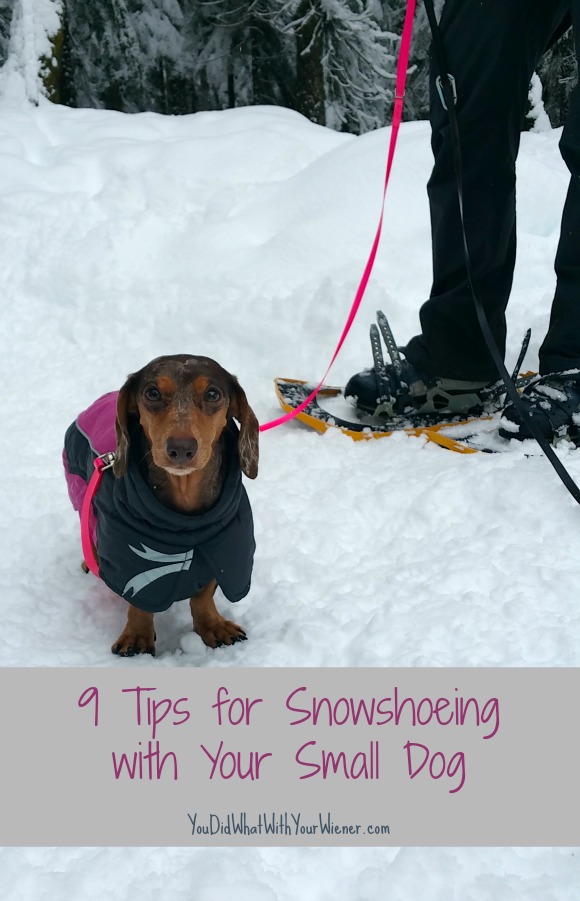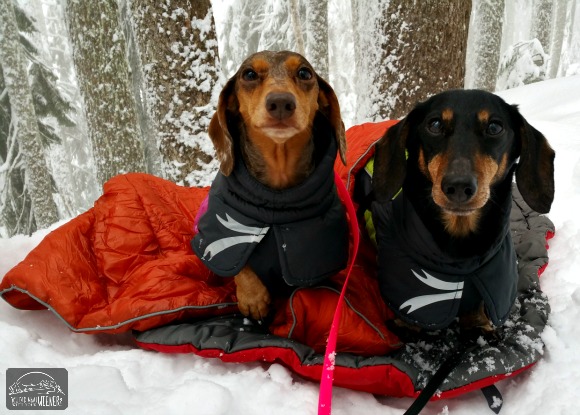9 Tips for Snowshoeing with Your Small Dog
Snowshoeing is a fun way to enjoy the silence of winter while hitting some of your favorite summer trails.
Summer trails become a whole new experience. A blanket of snow even makes trekking an abandoned logging road interesting.
And snowshoeing with dogs is the best. Even small dogs can do it!
UPDATED: January 8, 2023
Many people are surprised to know that taking your small dog on a snowshoe trip is possible.
It does take special consideration though.
You usually have to plan for trips that are a bit shorter because small dogs get cold and tired in the snow faster than big dogs.
Our first snowshoe trip of the year was almost 5 miles though and I was done at that point… so that doesn’t mean little dogs can’t keep up with the big dogs and humans.
By following these 9 tips, you can help make sure your small dog has a good experience in the snow and stays safe.

Note: some of the links below are affiliate links, which means that we get a few pennies if you make a purchase, at no extra cost to you, to help support this blog (and we really, really appreciate it!)
Safety Tips for Snowshoeing with a Small Dog
1) Make sure your dog is up to the challenge
Make sure your dog is fit and healthy enough to go on a snowshoe hike with you.
This is important for any dog but it’s especially important for small dogs.
Bounding through the snow takes a lot of energy.
Small dogs that are ready for snowshoeing have been told they are in “good health” by their vet and are used to walking or hiking regularly.
Start your snowshoeing adventures small – 1 to 3 miles – to make sure your dog can handle it and then work your way up to longer ones.
These exercises are also great to keep adventure dogs strong and injury free.
2) Walk on an already compacted surface
Walking on firm snow is easier for your small dog and so they can go further.
If the snow is hard on top, your small, light dog isn’t likely to sink into the snow very far.
The easy way to make sure the surface if firm enough for your little dog is to snowshoe on hard, crusty snow – some place where it hasn’t snowed for a while and/or many people have come before you and already packed the snow down.
You can also go to places where the snow has already been packed down by a snow groomer like a snow park or cross-country ski trails.
Be sure to check the regulations first though.
Some cross-country ski areas don’t allow snowshoers or dogs on the trails (and even if you are allowed, you are not allowed to walk in the skiers tracks) and some snow parks don’t allow dogs to mingle with snowmobiles for safety reasons.
3) Compact the snow yourself
If you find yourself in soft, powdery snow, make your dog their own track to walk in.
Ideally, at least two people in your party can walk ahead of the dog.
The first person makes depressions in the snow with their snowshoes.
The person behind them walks opposite of them (opposite steps) to pack down the snow that the first person didn’t.
This will make a decently packed track in the snow that your dog can walk in.
Popular summer hiking trails often have a track already made by the first people to visit after a snowfall. Sometimes that first person is you though.
Watch Chester and Gretel zoom through the tracks
4) Bundle your dog up keep them warm enough
Put as thick and warm of a coat on your small dog as you can without restricting their movement or causing chafing.
Also be sure it isn’t too big or baggy or their lets could get caught up in it (maybe only an issue for the long and low dogs. Ha, ha).
A small dog’s legs will likely get chilly in the snow but they can handle it as long as the core of their body is toasty warm.
Make sure the jackets are made of wool or synthetic material too because cotton doesn’t insulate when it’s wet.
My favorite super warm winter coat for my small dogs is the Extreme Warmer Jacket from Hurtta.
5) Protect their feet
Snowballs, and ice balls, can build up on the end of your dog’s toenails or in between their paw pads, an cause foot pain and sores.
To help reduce the chance that snow will stick to their feet, trim the hair between their pads, apply a paw balm like Musher’s Secret, and check their feet frequently on the trail.
This is another reason for a really warm jacket. Since dogs lose heat through their feet, snow is less likely to stick to them if their body temperature stays elevated.
Also, ice can be sharp and scrape or cut your dog’s paws.
While I think dog boots are not necessary in most situations, there are things you can do to help protect your dogs paw pads from getting scraped or torn.
Dog boots are still an option if your dog truly needs them, but be warned that they are hard to find for little dogs.
Or at least ones that are appropriate for hiking are hard to find for small dogs – most are merely fashion accessories.
Some small dogs, like Dachshunds, have twisty little feet so boots don’t fit very well.

6) Bring something for your dog to stand on
Keeping your dog’s feet off of the snow during breaks will help them stay warm and prevent frostbite.
Lay down a blanket your dog can nest in, and stand on, while you make your hot chocolate.
One of my favorite blankets to bring is the Rumpl Puffy Blanket.
7) Bring something warm for your dog to drink
Your pup will enjoy something warm to drink on the trail too.
Just like with people, it will warm their tummy and increase their core body temperature.
You can bring a thermos from home with warmed no-sodium, spice-free chicken or beef broth or warm some up with the same camp stove you brought to make your hot chocolate (PLEASE make sure you clean the pot first since chocolate is toxic to dogs).
My favorite thing to use is the instant bone broth from the Honest Kitchen.
8) Pick your dog up occasionally
Pick your dog up now and then if they need it and use your hands to warm their paw pads.
Although we should be proud that our small dogs “can do it” too, there is no shame in picking them up from time to time.
Picking your dog up gives them a break from working so hard too.
Most will want right back down to keep chasing and sniffing smells though.
9) Bring a bigger backpack
You will likely need to bring a bigger backpack to fit all of the extra stuff for your small dog.
Big dogs can wear backpacks and carry some of their own things.
Even if your small dog has their own backpack, the chance is that not much will fit in there.
I’ve found that a 40 L pack is the perfect size for us – holds all of the stuff but is not unnecessarily big.
My favorite for winter is the Osprey Kamber ski-snowboard pack because I can strap my snowshoes to it if we need to walk a bit before hitting snow.
Final Thoughts
Snowshoeing is a great way to enjoy some of your favorite trails in winter.
Just because there is snow on the ground, doesn’t mean you need to leave your small dog home.
However, it is true that it takes a but more preparation and gear to keep your small dog healthy and safe in the snow.
If you’re in Washington State, consider these easy snowshoeing trails near Seattle.
You can also find other dog friendly places you can snowshoe in Washington HERE.

About the Author
Hi, I’m Jessica. I’ve been studying the Dachshund breed since 2007, owned 3 of my own, and shared in the lives of thousands of others through their owner’s stories. When I’m not sharing what I know on this blog, you can find me hiking, camping, and traveling with my adventurous wiener dogs.

LOL…That would be me with the spoiled small dog on the trail. If it’s cold anyway.
Thank for the tips! We bought snow shoes this year and are excited to take our Chihuahua with us! Now we just need some snow….
I love the idea of going snowshoeing with our dogs. It would be tough with all four dogs, but when we finally get snow in our area, I’m definitely going to take over the Centennial Trail for some fun. I’ve found that our dogs can handle 15-20 minutes at a time. They want to stay out longer, but I have to bring Rodrigo in to dry off his feet and make sure the snowballs that collect between his toes melt.
That looks like a great family activity! Snow sure does make everything beautiful and those photos of Chester and Gretel are delightful!
I found this helpful, because even though my dogs are not small, we just got snowshoes this year and look forward to trying it out, if we ever get snow.
Merry Christmas!
It’s a lot easier to do with big dogs than small ones 🙂 I hope you have a blast and don’t forget to show us pictures!
I’m so glad I saw this! Taking my little Lhasa Apso snow shoeing this week!
Have fun! Will it be your first time?
They are so cute!! We love snowshoeing and it’s awesome that you take your littles!
In january I tried snowshoeing with my dachshund! After some walks I bought some babysocks for my dog’s paws. She was very happy with them and the walks where much easier after! Next january we will go snowshoeing again and I see that I bought the same pink-blue Hurtta coat for my dog! So happy with it.
Glad you loved the jacket.
This is great information. I was just talking to my dog about cross country skiing and snowshoeing. Where we live the winters are a bit intense not much snow and freezing cold. So I was looking for the perfect warm jacket for my little long and low weiner so that he could join in all the fun. (or any fin that we can find this winter)